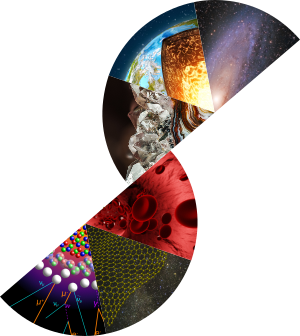Numerous studies have been conducted on inorganic oxy-hydroxy-fluoride compounds with the aim of determining their physicochemical properties [1-3]. As they govern these properties, their crystalline structures are of particular interest. Nevertheless, the efficiency of X-ray and neutron diffraction techniques, which are usually employed to determine crystalline structures, is limited since they are unable to distinguish between O and F atoms. In the case of ordered compounds, bond valence calculations allow distinguishing the crystallographic sites occupied by the O and F atoms. However, due to the close ionic radii values of fluoride (F-) and oxide (O2-) ions which allow them to share the same crystallographic site, inorganic oxy-fluoride compounds are often subject to the so-called chemical disorder. But between the limits of fully ordered and randomly disordered anions, there are many cases of intermediate anion orders that may give rise to non-random site occupancies in the averaged crystal structure, i.e. the so-called correlated disorder. For instance, for heteroanionic materials constructed from heteroleptic [MX2X'4] octahedral units, cis units are more favored [4], particularly when the cation is a d0 transition metal. Solid-state NMR spectroscopy (ss-NMR), which provide information about the local environment of the probe nucleus, coupled with DFT calculations, brings forth accurate modeling of the crystal structure, as shown in the past decade, on few disordered oxy-fluorides [5,6].
During my thesis, we have applied this combination in order to reach a full structural description of numerous ordered/disordered inorganic oxy-hydroxy-fluorides. Herein, we present the results obtained for oxy-trifluoride of niobium and tantalum MOF3 (M = Nb, Ta) [7] and the Hexagonal-Tungsten-Bronze phase of TiOF2 (HTB-TiOF2) [8]. Their crystalline structures, which show correlated disorder, were precisely modelled using X-Ray Powder Diffraction, 1H and 19F Magic Angle Spinning (MAS) ss-NMR and DFT calculations. Moreover, NbOF3 and HTB-TiOF2 being partially hydroxylated, the agreement between calculated and experimental data has been significantly improved by substituting partially F for OH in the models.
[1] M. Leblanc, V. Maisonneuve, A. Tressaud, Chem. Rev. 115 (2015) 1191–1254.
[2] T. Koketsu, J. Ma, B.-J. Morgan, M. Body, C. Legein, W. Dachraoui, M. Giannini, A. Demortière, M. Salanne, F. Dardoize, H. Groult, O.-J. Borkiewicz, K.-W. Chapman, P. Strasser, D. Dambournet Nat. Mater. 16 (2017) 1142–1148.
[3] J.-K. Harada, P.-H. Chien, H. Liu, S. Patel, C.-H. A. Chen, N. Charles, Y.-Y. Hu, K.-R. Poeppelmeier, J.-M. Rondinelli, Phys. Rev. Materials 5 (2021) 124401.
[4] J.-K. Harada, N. Charles, K.-R. Poeppelmeier, J.-M. Rondinelli, Adv. Mater. 31 (2019) 1805295.
[5] F. Ding, N. Charles, J.-K. Harada, C.-D. Malliakas, C. Zhang, R.-D. Reis, K.-J. Griffith, M.-L. Nisbet, W. Zhang, P.-S. Halasyamani, V.-P. Dravid, J.-M. Rondinelli, K.-R. Poeppelmeier, J. Am. Chem. Soc. 143 (2021) 18907–18916.
[6] J. Dabachi, M. Body, C. Galven, F. Boucher, C. Legein, Inorg. Chem. 56 (2017) 5219−5232.
[7] J. Köhler, A. Simon, L. van Wüllen, S. Cordier, T. Roisnel, M. Poulain, M. Somer, Z. Anorg. Allg. Chem. 628 (2002) 2683-2690.
[8] W. Li, M. Body, C. Legein, D. Dambournet, Cryst. Growth Des. 2016, 16 (9), 5441–5447.

 PDF version
PDF version
